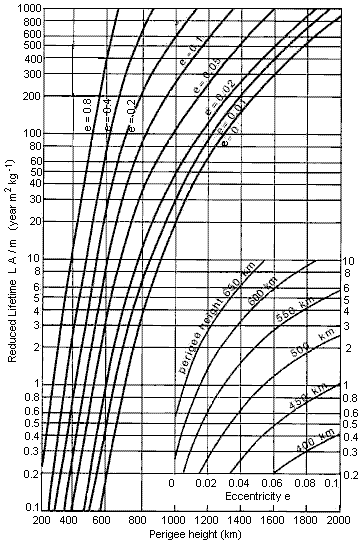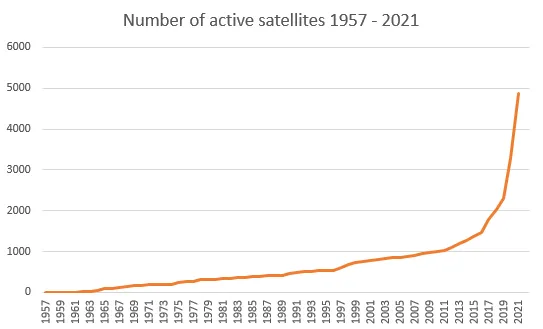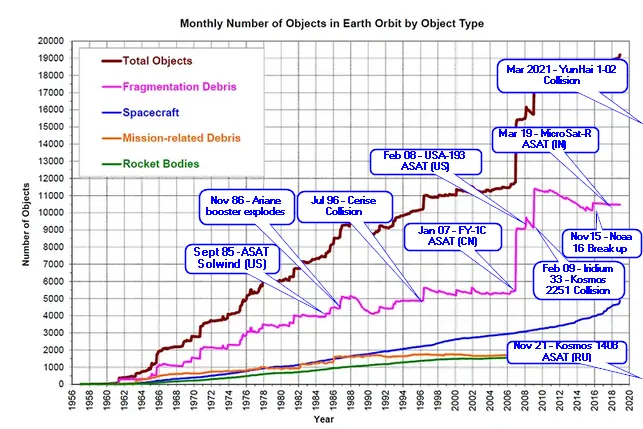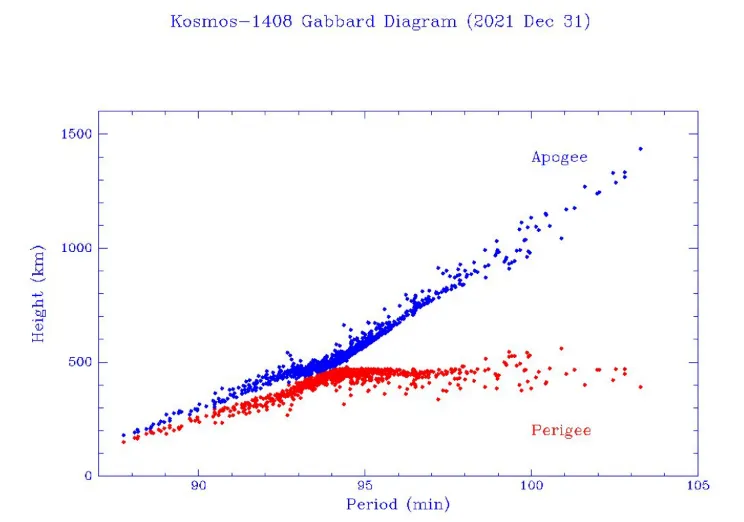In the last post we were talking about how there are many abandoned objects on space, and how the part of a rocket had crashed on the moon. And it is not only some abandoned components lost far away on space, these junk is also sharing the orbit close to Earth with our satellites.
When we speak about satellites being in orbit we have to remember that they remain spinning the Earth more or less in an ellipse / circle that repeats itself. The time they need do one orbit is related to their distance to Earth. This is just a simple application of the Law of Gravity. In an ideal world, those orbits would remain the same forever, however, the earth is not perfectly round and even high there, a thin atmosphere is present. Which means that something that is in orbit, remains in orbit for a period of time that can be relatively long.
In order to stablish some terminology, we usually divide the orbits in which the satellites are around the Earth in:
- Low Earth Orbit (LEO): 160 - 2000 km. ISS is orbiting around Earth at 400 km altitude in around 1h30min. Most of the commercial and Earth Observation satellites are in LEO, but the atmosphere drag is way bigger than in other orbits.
- Medium Earth Orbit (MEO): 2000 - 35786 km. Global Navigation Satellite Systems (GPS, Galileo) are usually placed at those orbits, more stable and with longer orbital periods of several hours. The major concern delaying the exploitation of these orbits are the increased radiation levels
- Geostationary Earth Orbit (GEO): 35786 km. An impressively useful orbit. The orbital period is 24h so in practice is like the satellite is stopped in a point of the sky over one point of the equator. Many of our communication satellites or the TV satellites are in this spot.
- High Earth Orbit (HEO): More than 35786 km. The orbit slower than the Earth, not so common.
And obviously, satellites stop working, sometimes could be because their components break, or they are not useful anymore. One of the main reasons to consider a satellite dying is because they run out of energy sources: either their batteries and solar panels cannot provide enough energy to make it work or they run out of fuel. And now you will think: "hey, you told me they were basically remaining in their same orbit", yes but not completely: you need some fuel to correct the orbit that keeps drifting (so you lose the stability of your orbit and it may become not useful for your scientific criteria) and your height also changes, so same as before, your orbit could stop being so useful if you cannot lift yourself from time to time.
So, for how long will these zombie satellites last there?

Source: Desmond King-Hele, Satellite Orbits in an Atmosphere - Theory and Applications, Blackie [Glasgow, 1987]
You can see that for orbits below 400 km the satellites will last there in between months to years. But many of the Earth observation and communication satellites are placed at 800 - 1300 km of altitude. Which means that they will last decades or centuries there!
Currently, there are some rules being encouraged so the operators clean up a bit their place when their satellite is about to die:
- The "25 year rule" for satellites in LEO. The objective would be make sure that your satellite re-enters into the atmosphere and stops being around in 25 years or less.
- The "Graveyard orbit" for satellites in GEO.

Source: Own elaboration with data from Statista
And it is starting to become important to start cleaning our space, as you can see in the plot on top the number of active satellites has kept a very stable growth rate. But in the last 10 years, the miniaturization of the technology together with the standardization and a more mature industry, has made skyrocket the number of them. Cheaper technologies also involve more failures and abandoned satellites. Of special debate is the concept of Mega-constellations, using thousands of satellites to provide wide coverage of the earth, but relying in many spacecraft, increasing the traffic problem up there.
Right now, SpaceX is the biggest operator of satellites, and other telecommunications companies like Iridium –with classic satellites- or OneWeb own relatively big constellations of satellites. In the Earth observation sector, Planet and Spire also have very large constellations of small satellites.
Ok, but we know where they are, right? right?
Not that much. Satellites are launched, and we can track them. In fact, as a rule more or less Space Situational Awareness systems track al the objects bigger than 10 cm. But a smaller piece -a screw for example- traveling at 7000 km/s is enough to kill a working satellite.

Source: NASA Orbital Debris Programme Office modified by me to add critical events.
And... not always everything goes ok. When we launch a satellite there is always some additional debris generated, parts that separate, break, the upper part of the rocket that remains in orbit. And additionally, sometimes satellites break, batteries have a tendency to explode when some things go wrong. As an example, 4 US meteorological satellites have exploded because of this reason:
| Satellite | Breakup date | Apogee - Perigee at breakup | Catalogued fragments | Fragments in orbit |
|---|---|---|---|---|
| NOAA-16 | 25 Nov 2015 | 858 x 842 km | 458 | 457 |
| NOAA-17 | 15 Apr 2004 | 817 x 800 km | 96 | 96 |
| DMSP F11 | 10 Mar 2021 | 850 x 830 km | 85 | 61 |
| DMSP F13 | 3 Feb 2015 | 840 x 840 km | 238 | 221 |
Source: NASA Orbital Debris Programme Office
And, to make it worse, it is not only satellites that break. Usually we are alert and keep monitoring that our satellites do not crash with a piece of trash and manoeuver the satellite. But we do not always know where the junk is as we were saying before and... there is another problem, some objects in orbit are just not active anymore, so they cannot dodge the junk or other satellites. The following table contains the known accidental collisions between catalogued objects:
| Date | Object 1 | Object 2 | Catalogued fragments |
|---|---|---|---|
| 23 Dec 1991 | Cosmos 1934 | Mission related debris | 3 |
| 24 Jul 1996 | Cerise * | Fragmentation debris | 96 |
| 17 Jan 2005 | DMSP 5B F5 Upper stage | Fragmentation debris | 7 |
| 10 Feb 2009 | Iridium 33 * | Cosmos 2251 | 2350 |
| 18 Mar 2021 | YunHai 1-02 * | Mission related debris | 37 |
(*) Operational in the moment of the impact.
Source: NASA Orbital Debris Programme Office
And in the plot you can see another type of events, what are those ASATs? Anti Satellite weapons. Yes. If we do not have enough with satellites breaking by themselves, ASAT kinetic weapons target a satellite with the objective of breaking it up. Of course there are other ways of attacking a satellite like blinding it with lasers o jamming their signals but this case, breaking them up, has got a lot of attention because of the impact they can have in the space environment and economy. The most famous one was the ASAT test of the Chinese FY-1C because it happened in a very crowded orbit at 800, and its debris will last hundreds of years there.
But it is not the only one of these events (note, all of them have been so far tests where countries break their own satellites), they were briefly tested in the cold war until a moratorium was imposed and after the Chinese ASAT in 2007, US, India and Russia have done their own tests. Indian and US satellites impacted at around 350 km so their debris will last way shorter but still it is not ideal.
Usually after an impact (accidental or voluntary) the experts used the so-called Gabbard plots to observe how the fragments expand. Because after a crash, pieces are thrown away in all directions.

Gabbard diagram for the first 904 debris objects cataloged from the event by Space Force. Source: Jonathan McDowell Space Activities in 2021
What the plot shows us are pairs of points of the orbit of the newly tracked objects. For each point we get the Apogee (the farther away to earth point in the orbit) and the Perigee (the closest). As we can see all this objects spread in many orbits, way higher than where the impact happened.
Of course this new fragments are subject to the decay rules we saw in the first plot but... some of them are so high that they will remain there for very long. And they are not always easy to track.
What can we do?
Aiming for responsible ways to operate looks the key. For a satellite operator, using the "responsible" ways to de-commission a satellite is costly. They need fuel to help deorbit their satellite or put it in the graveyard orbit. And it is a relatively energy consuming operation so it involves reducing the life of their satellite several years probably.
New techniques to reduce the time the objects will remain in orbit are being created, small satellites are testing "sails" and tethers that increase their drag to help them come back faster. Some operators have implemented greener deployment techniques after the original outcry on their strategies: Starlink satellites were originally deployed at the target altitude, but now the new strategy is to deploy them in a very low orbit that will ensure that the ones that do not survive a launch, will re-enter in some weeks (the ethics behind launching satellites with a high failure rate is another topic). The debate on removing debris is on the table, but will not be something fast.
And we can see how the awareness is increasing. Coordination mechanisms could be complicated and agreements are difficult to reach in the current geopolitical situation. But in general the tracking systems are improving and in general, a wider public attention can bring more responsibility in the operators.